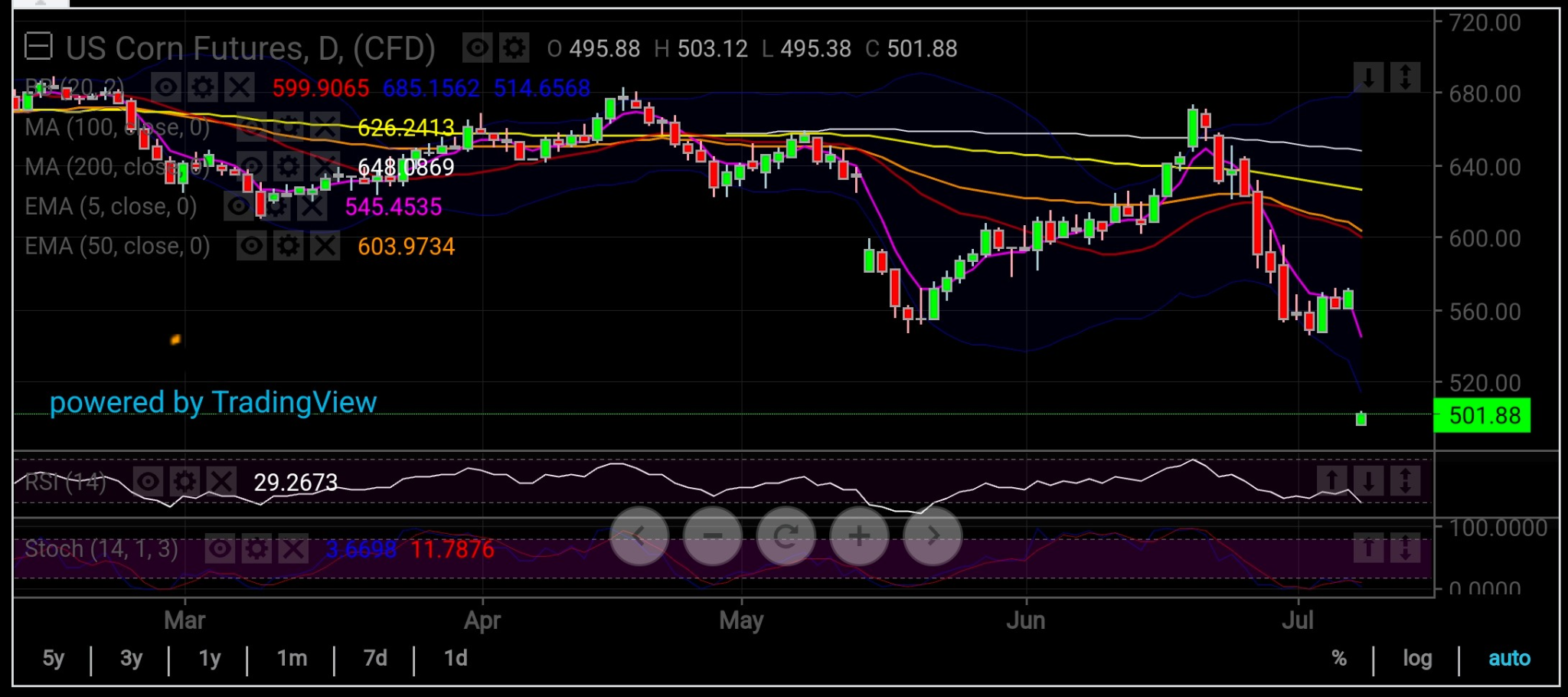Verizon to cut 15,000 jobs amid growing competition pressures - WSJ
- Corn hits 30-month low on poor fundamentals after late summer rally last year
- USDA crop report must show underwhelming output to restore market’s upside
- Corn’s technical outlook better than fundamental picture, charts show
Late last summer, corn was gearing for its biggest rally in 15 weeks as "prevent planting”, a form of crop rationing by U.S. farmers, added to the global squeeze in the grain’s supply.
On Monday, though, the market hit 2-½ year lows, falling beneath the $5-per-bushel support, as longs in the space struggled for direction as America’s largest crop experienced everything that could possibly go wrong.

Fundamentals
As grains analyst Jacqueline Holland said in a blog on the Farm Progress site, corn, first and foremost, needs “good news” from crop reports due later Wednesday from the U.S. Department of Agriculture or USDA.
Previous USDA reporting on June 30 showed strong usage rates for corn in the March to June period — a testimony that would have been supportive if not for a quick overshadowing of that by an unexpected corn acreage surge this spring.
With a more robust crop suddenly building up the balance sheet, Wednesday’s report will need to show some upward revisions to usage categories — not likely from exports, but maybe from ethanol — for corn to regain the $5-per-bushel perch, Holland wrote.
According to Energy Information Administration data published last Wednesday, weekly ethanol production neared a seven-month high last week. That has helped support cash markets for corn despite sluggish farmer sales.
Over at Chicago’s Price Futures Group, Jack Scoville, another seer of all crops, drew a picture for corn that was hardly more positive than that painted by Holland. He said,
“Demand for U.S. corn in the world market has been very low and domestic demand has also been weak due to reduced cattle and other livestock production,”
Like Holland, Scoville cited the upcoming USDA reports, emphasizing the importance that the agency projects an underwhelming situation on production rather than another boisterous one. He adds:
“Reports of dry initial development conditions were important. Ideas are that the top end of the yield potential is lost but that no serious damage has been done yet. Serious damage could be done to crops where the rains miss in the next few weeks.”
Elsewhere, Brazil’s corn harvest was underway, and export prices for South American grains were getting relatively cheap, “and Brazil is getting the business,” Scoville said.
The weather over major U.S. corn-growing areas also featured additional wetness in the next couple of weeks, adding to last week’s “already beneficial precipitation,” he added.
Brokerage Copenhagen Merchants, meanwhile, said in a note carried by Reuters:
"Volatility might persist ... there are only a few days remaining to agree (or not) on the extension of the Black Sea grain deal, and U.S. corn crops are entering the critical pollination period.”
There are growing concerns that renewing the Black Sea Grain Initiative could be more difficult than in the past when it expires on July 18. The initiative, last renewed in May, provides a safe transit corridor for agricultural commodities from war-torn Ukraine.
Technicals

Notwithstanding the gloomy fundamental picture for corn, its technical outlook was brighter as the market looked oversold and ready to rebound, said Sunil Kumar Dixit, chief technical strategist at SKCharting.com.
“After consistent consolidation in a 4-hour time frame, US corn futures will require a day/week closing above the 5-day EMA, or Exponential Moving Average, of $5.45.”
“If recovery from support areas gains affirmation above the 50-month EMA of $5.63, the next hurdle would be $6.15 and $6.35, followed by $6.45 and $6.61.”
But If selling intensifies, traders should expect a further drop below the 200-month SMA, or Simple Moving Average, of $4.80, followed by the 100-month SMA of $4.50, added Dixit.
Disclaimer: The content of this article is purely to educate and inform and does not in any way represent an inducement or recommendation to buy or sell any commodity or its related securities. The author Barani Krishnan does not hold a position in the commodities and securities he writes about. He typically uses a range of views outside his own to bring diversity to his market analysis. For neutrality, he sometimes presents contrarian views and market variables.
